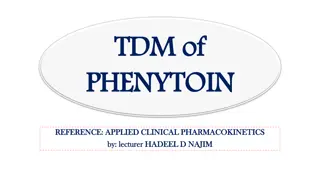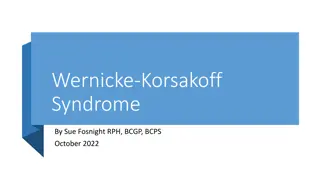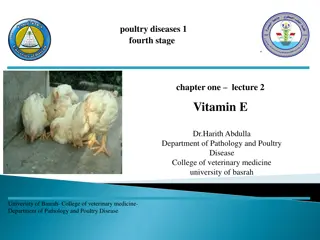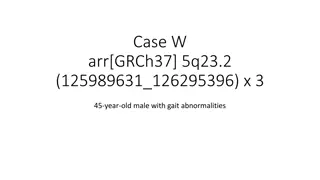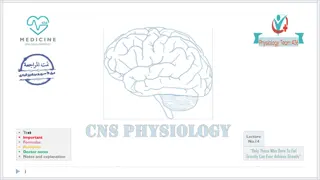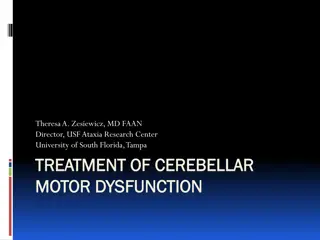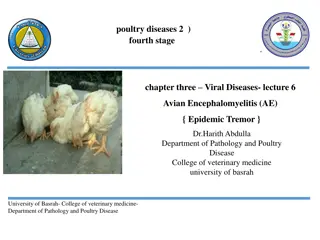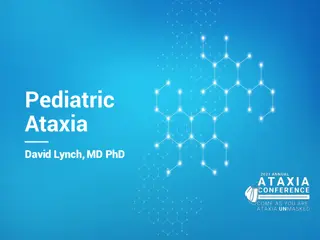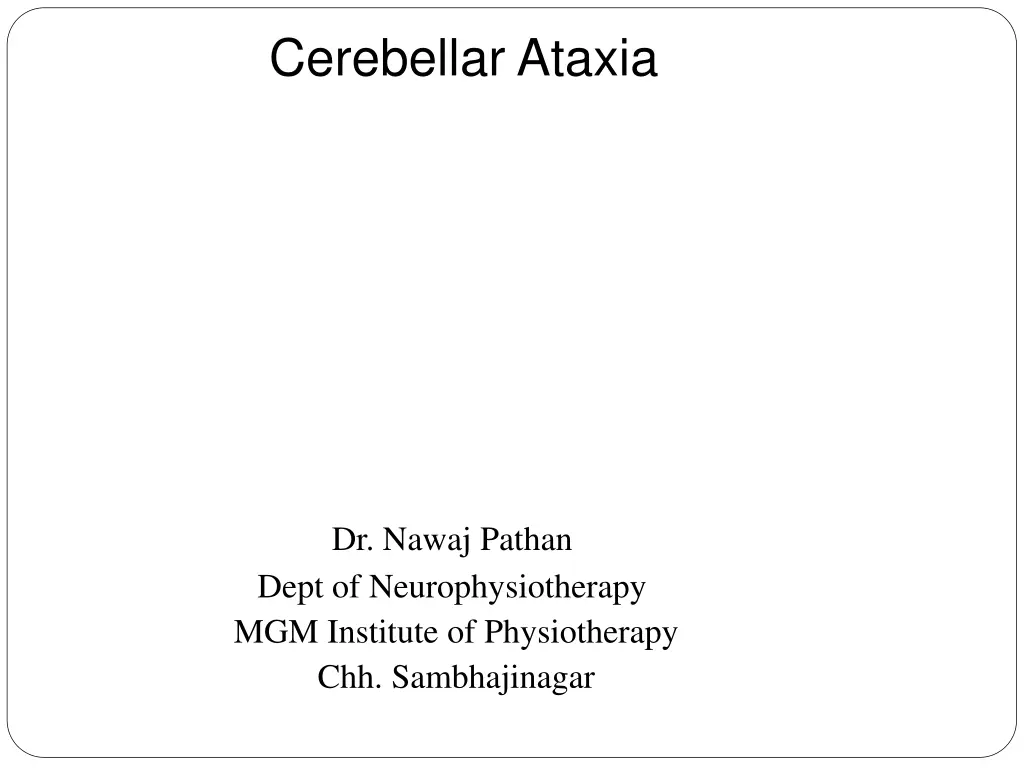
Understanding Cerebellar Ataxia: Symptoms, Causes, and Management
Learn about cerebellar ataxia, a condition characterized by abnormal movements, incoordination, and tremors. Discover its functional role in the central nervous system, causes, clinical signs, diagnostic tests, and treatment options. Explore the crucial role of the cerebellum in movement coordination and the implications of cerebellar dysfunction on posture and coordination.
Download Presentation

Please find below an Image/Link to download the presentation.
The content on the website is provided AS IS for your information and personal use only. It may not be sold, licensed, or shared on other websites without obtaining consent from the author. If you encounter any issues during the download, it is possible that the publisher has removed the file from their server.
You are allowed to download the files provided on this website for personal or commercial use, subject to the condition that they are used lawfully. All files are the property of their respective owners.
The content on the website is provided AS IS for your information and personal use only. It may not be sold, licensed, or shared on other websites without obtaining consent from the author.
E N D
Presentation Transcript
Cerebellar Ataxia Dr. Nawaj Pathan Dept of Neurophysiotherapy MGM Institute of Physiotherapy Chh. Sambhajinagar
Contents Introduction Functional role of cerebellum Etiology Clinical signs Investigations Management
Introduction Ataxia means not ordered . term used to describe a no. of abnormal movements that may occur during the execution voluntary movements. This includes incoordination, delay in movements, dysmetria(inaccuracy in achieving target),disdidokinesia (difficulty in performing movements of constant force & rhythm) & tremor. Control of movements is distributed throughout the central nervous system(CNS)
The cerebellum has part to play within this distributed system by functioning closely with other parts of the CNS- motor cortex, basal ganglia, vestibular system & spinal motor system. The main role of cerebellum is concerned with the- 1. timing 2.coordination & integration of movements, including eye movements & Speech. Therefore lesions affecting the cerebellum would results in a disorder of movements, coordination often termed as- Cerebellar Ataxia
Often it may also associated with postural unsteadiness,in- cordination with other possible sign- Titubation/ Tibulation , nystagmus. The characteristic of movement disorders resulting from cerebellar dysfunction have been described in early 20th century by Gordon Holmes.
Functional Role of Cerebellum Although cerebellum constitute about 10% of the brain s total volume; it contains more than half of the total no of neurons in the brain. Cerebellum regulates vestibular, spinal & cortical mechanisms by means of reciprocal neuronal connections. Structurally cerebellum composed of main 2 parts- cerebellar cortex & deep cerebellar nuclei.
These parts receives afferent pathways from other parts of CNS, mainly the cerebral cortex. The efferent pathways that leave the cerebellum mainly arise from the deep nuclei, after receiving the outputs from cerebellar cortex projects back to cerebral cortex & other parts of CNS.
The cerebellum sends no pathways directly to the spinal cord but participates in 3 main functions i.e. vestibulo- cerebellar- modulates postural balance, eye movements, spino-cerebellar modulates muscle tone, posture & locomotion. The cerebro-cerebellar system thought to play a role in regulating skilled movements, motor planning.
The cerebellum has the connections to carry out this role, receiving inputs from the periphery & from all levels of CNS. It includes internal feedback- also termed as corollary feedback, mainly concerned to motor planning & forthcoming execution of motion. It also receives input from external feedback from sensory receptors during movements & compares intended movements with the actual movements as it unfolds. Therefore movements can be corrected when they deviate from the intended course.
The role of the cerebellum is sometimes described as enriching the movement quality It act as movement regulatorory center for the control of motor activity & participating in the construction of synergy. The cerebellum plays an important role in timing & sequencing of muscle activation during movements, plays vital role in postural control also.
Etiology Lesion of the cerebellum may result from- Developmental abnormalities Hydrocephalous, hypoxia at birth. Traumatic brain injury Infections such as encephalitis Demylinating disease- Multiple sclerosis Hereditary disease friedreich s ataxia Degenerative disease Metabolic disease Vascular insufficiency Drug abuse & alcohol intoxication.
Clinical signs Unilateral lesions affect the ipsilateral side of the body Classically it is described as- Dysmetria Dyssynergia Dysdiadochokinesia Rebound phenomenon Tremor Hypotonia Dysarthia Nystagmus
Dysmetria Dysmetria is demonstrated by inaccurate amplitude of movement and misplaced force & reflects the impairment in timing of muscle force. There is excessive extent of movement or overshooting(hypermetria) or deficient extent of movement (hypometria) also seen in cerebellar dysfunction. hypermetric movements may be more marked in small, fast, aimed movements & postural adjustments,while hypometric are seen in slow movements with small amplitude
Cerebellar dysmetria occurs proximally and distally in both upper and lower limbs. It affects single joint as well as multi joint movements.
Rebound Phenomenon This phenomenon demonstrate the dysfunction of agonist- antagonist relationship. When subject is asked to perform voluntary movements against examiner s resistance and when resistance suddenly released; person is unable to stop the resultant movement. It leads to overshoot and rebounds excessively.
Disdiadochokinesia The term denotes difficulty in performing rapid alternating movements such as pronation-supination The movements are generally clumsy and slowly. Its shows the irregular pattern of movement when person asked to perform rapid movements.
Tremor Tremor is oscillating movements about joint due to alternating contractions of agonist and antagonist. It occurs only during movements not at rest hence called as intention tremor/kinetic/ goal directed tremor. It is commonly tested through finger to finger test. Cerebellar tremor is classically marked at the end of movement or during the whole ROM so that it is also called as Terminal tremors . A truncal or postural tremor may also present when the person is trying to stand or sit still.
Dyssynergia It also termed as Movement Decomposition It demonstrate a lack of co-ordination between agonist, antagonist & other synergic muscles It leads to lack of smooth, sequential performance of various components of motion It is commonly seen in heel-Shin test. Person with cerebellar dysfunction may show jerky, overshooting movements.
Dysarthia Speech is slurred and slow. Person may use prolonged syllables It is may be due to lack of co-ordination of oral musculature & breathing.
Ataxic Gait One of the hallmark sign of cerebellar disorder is ataxic gait. Typical features of this gait is- Widened BOS Unsteadiness irregularity in stepping and direction Reduced stride length & cadence. When patients are asked to perform tandem walk patient may finds difficulty to execute. Tandem walk we can be use for testing and training progression.
Asthenia In cerebellar lesions Asthenia is very common, in which patient may complain of generalized weakness. Patient may describe it as a sense of heaviness, with excessive efforts for simple tasks. Patient may complain -early onset of fatigue in basic activity of daily living.
Hypotonia The spinocerebellum has been linked to the problem of decreased tone or hypotonicity. This is mainly because of decrease in excitation from the cerebellar deep nuclei to regions of the brain that excite alpha and gamma motor neurons. The muscle itself feels less firm to palpation, and when the therapist examines passive range of motion, limb will appear heavy
Deep tendon reflexes are typically normal, But there is often a pendular movement of the limb after the initial muscle contraction response. During a knee jerk. the leg behaves as a pendulum, that falls by its own weight and oscillates momentarily because of momentum. Conventional test for hypotonia is to tap the wrists of the outstretched arms, in which the affected limb is displaced through the wider range normal and may oscillate.
This can be seen because of failure of hypotonic muscle to fixate the arm at the shoulder.
Assessment and test Interpretations
Component Special Tests Positive Hypotonicity Muscle palpation Reduced firmness Deep tendon reflexes Pendular Passive shaking of limbs Limbs move through greater arc of motion than does normal limb Print broader on involved side Wet footprint Flex one finger only Hold object while conversing All fingers flex Drops object when distracted Voluntary flexion and extension of Ataxic when unsupported controlled when
Asthenia Special Tests Resting posture Maintain arms) in 9O-degree position of flexion or abduction Maximal resisted muscle contraction for major muscle groups Positive Slack, asymmetrical Arm(s) tire quickly Weaker on involved side or unable to work against resistance. which is normal for size and age Tires quickly Repeat sub maximal muscle contractions. such as, rising on toes, pushups, squeezing tennis ball
Postural Control Special Tests Positive Everyday activities Tires easily. complains of heaviness Postural tremor Hold limb against pull of gravity Nudge the patient unexpectedly when sitting or standing Loses balance easily Stand on one foot or walk backward Loses balance easily Feel apart. trunk flexed slightly. needs to hold for stability, tremors in legs Standing posture
Dysmetria Special Tests Positive Therapist resists client's elbow flexion and release. .. unexpectedly slide heel down shin slowly, Arm rebounds Intention tremor place feet on markers when walking Intention tremor, undershoots. or overshoots Target
Gait Disturbances Special Tests March to cadence Walk on heels or toes Positive Unable to follow rhythm Loses balance and rhythm Walk clockwise and counterclockwise Stumbles in one direction Walk on uneven ground Cannot compensate and Stumbles Typical gait pattern Slow, stumbles easily, not rhythmical. step length and height irregular Disdidokinesia Tap hand on knee or toes on floor Rapidly loses rhythm and range Activities of daily living Unable to brush teeth. Stir food, shake salt shaker, pouring water in glass, unable to drink


